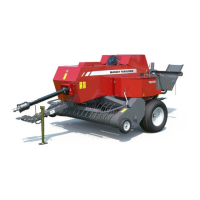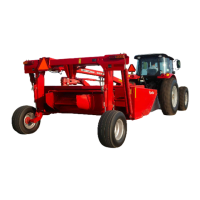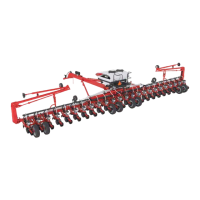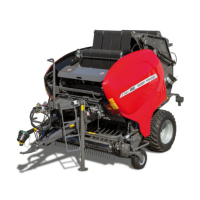Do you have a question about the MASSEY FERGUSON 1843S and is the answer not in the manual?
Overview of the manual's purpose and scope.
Explains the use of metric and U.S. units for measurements.
Lists information needed for ordering replacement parts efficiently.
Details on how to identify the baler model and serial number.
Fields for recording dealer contact information for service.
Location and identification of the baler and engine serial number plates.
Location of the manual container and instructions for its use.
High-level description of the baler's capabilities and operation.
Identifies key external components of the baler with numbered labels in an image.
Explanation of how power is transmitted from the engine to the baler mechanisms.
Description of the pickup clutch's function and type.
Details on how the baler picks up and feeds crop into the chamber.
Explains the purpose and power source of the baler's hydraulic system.
Describes how bale density and weight are controlled via hydraulic pressure.
Overview of the baler's 12-volt electrical system and its functions.
Description and function of the baler control console mounted in the towing vehicle.
General advice on periodic inspection and tightening of components.
Guidelines for tightening bolts, emphasizing correct torque and bolt grade identification.
Lists components and lubrication/maintenance frequency based on operating hours.
Covers wheel bearings, sealed bearings, wheel bolts, and bearing replacement procedures.
Explains the function and locations of shearbolts for component protection.
Instructions for lubricating roller chains to ensure efficiency and longevity.
Guidance on covering wiring harness connectors to protect against dirt and moisture.
Step-by-step instructions for replacing bearings using eccentric self-locking collars.
Procedures for removing and installing gib keys, including tool usage.
Explains the operation and maintenance of the hydraulic system for bale density control.
Instructions for checking the gearbox oil level and maintenance.
Guidance on lubricating grease fittings, including frequency and cleaning.
Instructions for lubricating the stuffer crank, specified for 10-hour intervals.
Instructions for lubricating the pickup overrunning clutch, specified for 20-hour intervals.
Instructions for lubricating needle carriage tie rods, specified for 20-hour intervals.
Instructions for lubricating the baler drive belt tension bracket, specified for 50-hour intervals.
Instructions for lubricating U-joints and slip tubes on the drive shaft, specified for 50-hour intervals.
Instructions for lubricating the tongue pivot, specified for 50-hour intervals.
Instructions for lubricating the flywheel (50 hrs) and gearbox (200 hrs).
Instructions for lubricating pickup drive shaft U-joints, specified for 50-hour intervals.
Instructions for lubricating the knotter clutch arm pivot, specified for 50-hour intervals.
Instructions for lubricating plunger connecting rods, specified for 50-hour intervals.
Instructions for lubricating the knotter trip arm pivot, specified for 50-hour intervals.
Checklist of tasks to perform before the start of a new baling season.
Recommended procedures for storing the baler at the end of the season.
Introduction to safety information, symbols, and messages in the manual.
Explains the meaning and importance of the safety alert symbol.
Advice on checking, replacing, and locating safety signs on the baler.
Explains the meaning of DANGER, WARNING, and CAUTION messages.
Explains the meaning of IMPORTANT and NOTE messages.
Emphasizes operator responsibility for safety and understanding the manual.
Guidelines on wearing appropriate protective clothing and equipment.
Warnings against operating under the influence and general safe operating practices.
Specifies maximum towing speed, vehicle weight requirements, and safety chain usage.
Provides measures to reduce the risk of fire and what to do if one occurs.
Outlines essential safety steps before performing maintenance, lubrication, or adjustments.
Overview of the manual's purpose and scope.
Explains the use of metric and U.S. units for measurements.
Lists information needed for ordering replacement parts efficiently.
Details on how to identify the baler model and serial number.
Fields for recording dealer contact information for service.
Location and identification of the baler and engine serial number plates.
Location of the manual container and instructions for its use.
High-level description of the baler's capabilities and operation.
Identifies key external components of the baler with numbered labels in an image.
Explanation of how power is transmitted from the engine to the baler mechanisms.
Description of the pickup clutch's function and type.
Details on how the baler picks up and feeds crop into the chamber.
Explains the purpose and power source of the baler's hydraulic system.
Describes how bale density and weight are controlled via hydraulic pressure.
Overview of the baler's 12-volt electrical system and its functions.
Description and function of the baler control console mounted in the towing vehicle.
General advice on periodic inspection and tightening of components.
Guidelines for tightening bolts, emphasizing correct torque and bolt grade identification.
Lists components and lubrication/maintenance frequency based on operating hours.
Covers wheel bearings, sealed bearings, wheel bolts, and bearing replacement procedures.
Explains the function and locations of shearbolts for component protection.
Instructions for lubricating roller chains to ensure efficiency and longevity.
Guidance on covering wiring harness connectors to protect against dirt and moisture.
Step-by-step instructions for replacing bearings using eccentric self-locking collars.
Procedures for removing and installing gib keys, including tool usage.
Explains the operation and maintenance of the hydraulic system for bale density control.
Instructions for checking the gearbox oil level and maintenance.
Guidance on lubricating grease fittings, including frequency and cleaning.
Instructions for lubricating the stuffer crank, specified for 10-hour intervals.
Instructions for lubricating the pickup overrunning clutch, specified for 20-hour intervals.
Instructions for lubricating needle carriage tie rods, specified for 20-hour intervals.
Instructions for lubricating the baler drive belt tension bracket, specified for 50-hour intervals.
Instructions for lubricating U-joints and slip tubes on the drive shaft, specified for 50-hour intervals.
Instructions for lubricating the tongue pivot, specified for 50-hour intervals.
Instructions for lubricating the flywheel (50 hrs) and gearbox (200 hrs).
Instructions for lubricating pickup drive shaft U-joints, specified for 50-hour intervals.
Instructions for lubricating the knotter clutch arm pivot, specified for 50-hour intervals.
Instructions for lubricating plunger connecting rods, specified for 50-hour intervals.
Instructions for lubricating the knotter trip arm pivot, specified for 50-hour intervals.
Checklist of tasks to perform before the start of a new baling season.
Recommended procedures for storing the baler at the end of the season.
Introduction to safety information, symbols, and messages in the manual.
Explains the meaning and importance of the safety alert symbol.
Advice on checking, replacing, and locating safety signs on the baler.
Explains the meaning of DANGER, WARNING, and CAUTION messages.
Explains the meaning of IMPORTANT and NOTE messages.
Emphasizes operator responsibility for safety and understanding the manual.
Guidelines on wearing appropriate protective clothing and equipment.
Warnings against operating under the influence and general safe operating practices.
Specifies maximum towing speed, vehicle weight requirements, and safety chain usage.
Provides measures to reduce the risk of fire and what to do if one occurs.
Outlines essential safety steps before performing maintenance, lubrication, or adjustments.
| Brand | MASSEY FERGUSON |
|---|---|
| Model | 1843S |
| Category | Farm Equipment |
| Language | English |











